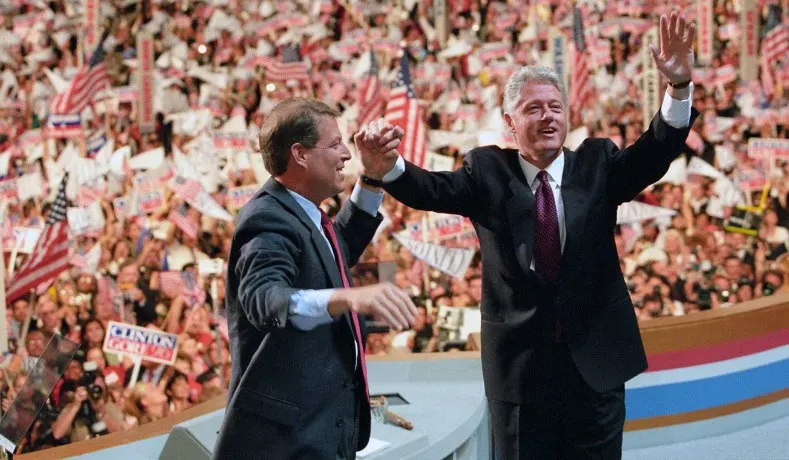| George H.W. Bush: | Bill Clinton: | Toss Up: |
1992 Election Results
President George H.W. Bush (R) was defeated in his re-election bid by Arkansas Gov. Bill Clinton (D) on November 3, 1992.
Clinton received 370 electoral votes, while Bush received 168 votes. The popular vote ended with Clinton receiving 43% of the vote, Bush receiving 37.4% of the vote, and independent candidate Ross Perot receiving 18.9% of the vote.
The 1992 electoral map is above. Click on the states in the map to toggle them between Democrat, Republican and Tossup.
Primaries
Bush faced a primary challenge from conservative pundit Pat Buchanan. Buchanan’s focus on social policies including ending abortion and limiting immigration allowed the candidate to stay competitive into the March primaries. Bush ultimately won every primary on his way to the party’s nomination, though Buchanan was given the keynote address at the party’s nominating convention to satisfy Buchanan delegates. Vice President Dan Quayle was nominated for a second time as Bush’s running mate.
The Democratic nominating process was more competitive with five candidates ultimately winning primaries. Iowa Senator Tom Harkin, former U.S. Rep. Paul Tsongas from Massachusetts, former California Governor Jerry Brown, Nebraska Senator Bob Kerrey, and Arkansas Governor Bill Clinton each won primaries through the first two months of the race. Clinton’s campaign gained momentum from a second-place finish in New Hampshire that carried over into substantial victories in March’s Southern primaries. Clinton clinched the nomination by June and joined vice presidential candidate and Tennessee Senator Al Gore on the Democratic ticket.

Central Issues
Bush’s approval rating peaked at 89% in the Gallup Poll by February 1991 following the country’s involvement in the Persian Gulf War. By the start of the presidential election, however, economic issues trumped foreign policy in the minds of voters. The unemployment rate grew during Bush’s presidency from 5.3% in 1989 to 7.5% in 1992. Bush also faced scrutiny over income tax increases signed in 1990 after a pledge of no new taxes during his nominating speech at the1998 Republican National Convention.
By January 1992, Bush had a 45% approval rating in the Gallup Poll. Clinton seized on economic issues by supporting healthcare cost regulation, job creation programs, and government-supported productivity. Bush focused on his administration’s oversight of the end of the Cold War and the Persian Gulf War. His campaign also highlighted Bush’s free-market economic principles and socially conservative policies as demanded by conservatives within the Republican Party.
Ross Perot’s Candidacy
Voter discontent with the Democratic and Republican parties along with the rise of economic issues encouraged Ross Perot to enter the race as an independent. The Texas billionaire entered the race in March 1992 and campaigned on balancing the federal budget and a re-commitment to the war on drugs. By June 1992, Perot led the Gallup Poll with 39% of respondents to Bush’s 31% and Clinton’s 25%.
Perot’s popularity declined in the summer and his campaign was in disarray after disagreements between the candidate and his advisors. Perot withdrew from the race on July 15 to avoid an Electoral College split decided by the House of Representatives. He re-entered on October 1 and deployed campaign infomercials and other marketing tools to promote his economic policies.
Perot’s re-entry into the race allowed him to participate in three presidential debates in October 1992. In all three debates, Bush attempted to discredit Clinton by criticizing his draft record, stories about his behavior, and alleged fluidity on policy. Clinton criticized Bush’s economic record and promoted his experiences as governor of Arkansas. Perot reiterated his budget position while promising to only serve one term.
Electoral Strategy
Clinton’s victory in 1992 relied in part on campaign staff managing how Americans learned about the relatively unknown governor. Despite accusations of infidelity and draft dodging during the primaries, most Americans were not familiar with Clinton. The Clinton campaign made efforts to soften opposition attacks with appearances on MTV and The Arsenio Hall Show. In these appearances, Clinton spoke of his low-income upbringing as the context for his professional successes while maintaining message discipline about economic policies.
The Clinton campaign also worked to break Republican dominance over the Northeast and the South. Republicans dominated both regions in 1980, 1984, and 1988 with the South a focus of Republicans going back to the Nixon presidency. Clinton won all of the Northeastern states, the first time a Democratic candidate achieved this feat since 1964. The Clinton/Gore ticket made inroads into the South by winning Arkansas, Georgia, Kentucky, Louisiana, Missouri, and Tennessee.
Perot’s presence on the ballot may have also pulled support from Bush. Clinton won 22 states that Bush carried in his 1988 victory over Michael Dukakis. In a majority of states, Perot’s vote total exceeded the margin of victory in that state by Bush or Clinton. Perot did not win any electoral votes, however, and the 1992 election results showed Clinton with a clear Electoral College victory.
